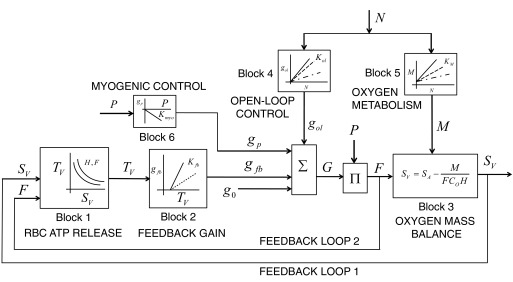Fig. 2.
Block diagram of the combined feed-forward, feedback, and myogenic control scheme for integrated control of coronary blood flow in vivo. The net vascular conductance (G) for coronary flow (F) is the summation of contributions to conductance from the open-loop pathways (gol), feedback pathways (gfb), myogenic pathway (gp) and basal conductance (g0). An input driving signal, assumed proportional to interstitial norepinephrine concentration, N, simultaneously affects the open-loop conductivity and myocardial oxygen metabolism (M), through blocks 4 and 5. The parameter Kol represents the open-loop gain, KM is the metabolic open-loop gain, Kfb is the metabolic feedback gain, and Kmyo is the myogenic gain. Through block 6, the myogenic contribution to conductance depends on the coronary arterial pressure P. Block 1 represents a model that predicts plasma ATP concentration, TV, in coronary venous blood as a function of hematocrit H, flow F, and venous oxygen saturation SV.

